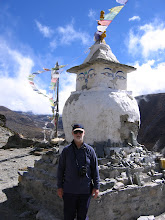21 July 1994 – My diary notes reveal that we left Bujuku Hut just after 10am heading for Elena Hut. This was, without doubt, one of the hardest days we had in the Ruwenzoris. Bujuku Hut is at around 3970 metres ASL and Elena Hut is at 4540m – the highest hut in the Ruwenzori Ranges and basically the midpoint of the trek.
Our journey to the Ruwenzoris was anything but straightforward. It started in 1992 when I was all but immobilised at home in Canberra with a ruptured lumbar disc. During recovery and learning to self-manage the condition, my doctor - ?Bell – encouraged me to take a more holistic approach to managing my life. He encouraged me to think about what I would do if money was no object. The back trauma provided an ideal opportunity or this sort of re-appraisal so I was quite happy to consider possibilities.
Beginnings
I’d recently been reading ‘The Last Hero’ (not the Terry Pratchett Discworld novel) but the one by Peter Forbath which tells the highly fictionalised story of Henry Morton Stanley’s real expedition to the Upper Nile region via the Congo River to rescue Emin Pasha after the fall of Khartoum in 1885. The journey takes Stanley close to the Ruwenzori Mountains and the source (or one of them) of the Nile. It is a stirring tale and awakened my interest in visiting a part of Africa which I had not been to.
At around the same time I had also read Alan Moorehead’s popular history ‘The White Nile’ which tells the history of European exploration and colonisation of the Nile region and, of course, the search for the source of the Nile. In conjunction with Forbath’s novel this book was sufficient to make one of my new ‘life goals’ to be to visit the regions discussed. Further research into the region threw up the possibilities of trekking the Ruwenzoris and so the idea was born. It was not yet a plan but at least the basis of something to plan for.
About the Ruwenzoris
The Ruwenzori Range is thought to be the ‘Mountains of the Moon’ mentioned by Ptolemy but the identification is not absolutely certain. Nevertheless, the poetic name sticks and is appropriate given the mystique that the range has. It is frequently misty or cloudy and it is rare to sight the peaks at all. The first European sighting was from the Stanley expedition in 1889 (see “The Last Hero” above) and the first ascent of the highest peak (to 10, 677 feet) was by Stanley’s expedition's 2IC William Stairs.
Margherita Peak is the highest summit of Mt Stanley and was named by the Duke of the Abruzzi during his 1906 expedition. It is the third highest peak in Africa after Kilimanjaro and Mt Kenya at 5109 metres.
The geography and vegetation is quite stunning with many plant species such as giant heather, lobelia and groundsel present here which are not found in any other location.
In keeping with the misty/cloudy nature the terrain is very wet with much of the trekking path being through extremely boggy areas. River crossings could be a challenge in earlier times but are generally easy now that the bigger rivers are crossed by modern bridges.
Treks of the central circuit, taking 7 or 8 days, depending on whether or not Margherita Peak is to be attempted, are organised from the Western Ugandan town of Kasese.
Subscribe to:
Post Comments (Atom)





No comments:
Post a Comment